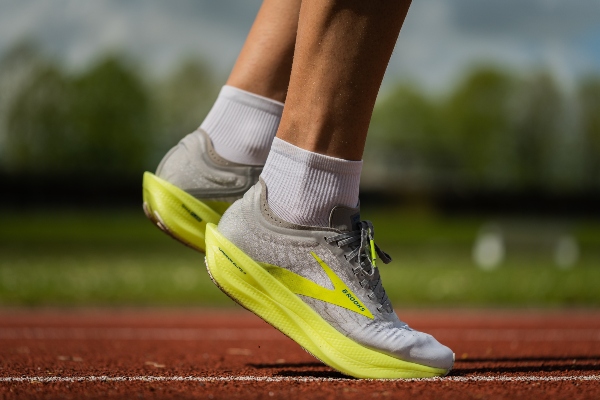Running Shoe Clinic 101
By Paul Baltutis
The good news: There’s a wide selection of styles and varieties of running shoes. The bad news: There is a wide selection of styles and varieties of running shoes. Yes, there are many bands, models, categories and technical terms to learn, such as pronation, supination, and biomechanics, so how can you possibly sort all this out?
After owning over 120 pairs of running shoes (four pairs a year for 30 years) and by working at a running store for the past five years, I’ve learned a few things about the selection process and the shoe industry. Here are some helpful tips on running shoes:
Determine what foot type you have
Do you have a high arch, medium arch, or are you flat-footed? You can determine this by getting your feet wet and standing on a brown paper bag. Now look at the impression left behind. Compare it to the graphics to the left. Each of the three foot types operates differently, and the shoe manufacturers factor this into the design of the shoe.
High arch
High arches appear like caverns under your feet, and the accompanying bone structure of this foot type is generally rigid and firm. I equate these to truck suspension on a vehicle. The suspension is solid, but the ride is firm. This foot type is considered suppinating (rolling to the outside) or neutral. The proper shoe for runners in this category should provides cushioning while not changing the basic motion of the foot. This type is called cushioning or neutral category.
Medium arch
Medium arches and mid-range arches display more inward flex or pronation than a high arch. Given the vehicle analogy, the average arch is like a standard car sedan. This arch type provides reasonable shock absorption and flex; however, since the motion of the arch goes inward, a greater degree of firm arch support is needed to keep the foot properly aligned The shoe industry calls this type the stability category.
Low to flat arch
The characteristic that best describes this category is over-pronation. The lower the arch, the more flexible it is, and while the flat foot distributes shock very effectively, the arch is so flexible that it goes “overboard.” The best vehicle analogy is a sedan with a mushy or a too-springy shock absorber. Picture a lowrider car that has hydraulic shocks installed and keeps bouncing up and down. For your foot, however, this excessive pronation needs additional support to control this excessive motion and is called motion control shoes.
Once you know the category that fits your kind of foot, try several brands and see how they feel on your feet. Simply trust your foot to tell you what feels natural and comfortable. While you can certainly do this on your own, going to a specialty running store with a knowledgeable sales staff is a smart way to find out what will work best for you. Getting a good fit is still a trial and error process, but a little knowledge goes a long way toward making your running experience the best it can be.
Paul Baltutis, is manager of Soler’s Sports and a certified marathon coach for Team in Training. For more information, please contact Paul Baltutis via e-mail at sage_run03@yahoo.com.






